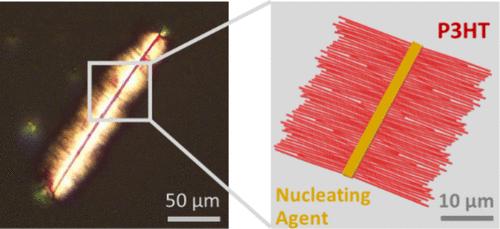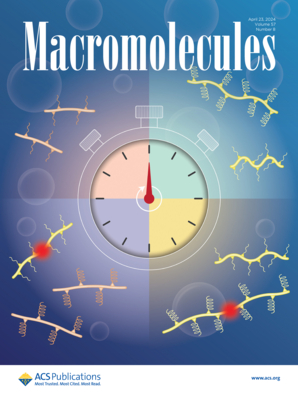Isolated Hierarchical Superstructures with Highly Oriented P3HT Nanofibers
IF 5.1
1区 化学
Q1 POLYMER SCIENCE
引用次数: 0
Abstract
The preparation of supramolecular mesoscale structures with high intrinsic order and orientation based on π-conjugated systems is of fundamental interest for studying their photophysical characteristics as well as for potential applications in (nano)photonics. However, the preparation, isolation and transfer of individual structures to substrates without compromising their structural integrity is challenging. Here we report on the controlled formation of hierarchical superstructures based on poly(3-hexylthiophene) (P3HT) comprising highly ordered and oriented P3HT nanofibers with lengths of up to 20 μm via a two-step self-assembly process. In the first step, we prepare defined supramolecular ribbons of N,N′-1,4-phenylenebis[4-pyridinecarboxamide]. In the second step, these ribbons act as efficient nucleation sites for the transcrystallization of P3HT into μm-long nanofibers from solution. The resulting shish-kebab-like superstructures can be purified and deposited on substrates without compromising their structural integrity. The densely packed and well-arranged P3HT nanofibers within the isolated superstructures feature a high orientational order parameter close to one up to a distance of 15 μm away from the initial nucleation sites. A systematic variation of photoluminescence spectra along the P3HT nanofibers in isolated superstructures indicates an increasing defect density toward the nanofiber end due to fractionation during growth. We anticipate that these findings can be transferred to designing and realizing superstructures as components for nanophotonic devices or light-harvesting antennae.

高取向 P3HT 纳米纤维隔离式分层超结构
基于π-共轭体系制备具有高内在有序性和定向性的超分子介尺度结构,对于研究其光物理特性以及在(纳米)光子学中的潜在应用具有重要意义。然而,如何制备、分离单个结构并将其转移到基底上,同时又不损害其结构的完整性是一项挑战。在此,我们报告了基于聚(3-己基噻吩)(P3HT)的分层超结构的可控形成,该结构包括高度有序和定向的 P3HT 纳米纤维,其长度可达 20 μm。第一步,我们制备出确定的 N,N′-1,4-亚苯基双[4-吡啶甲酰胺]超分子带。在第二步中,这些分子带可作为有效的成核点,将 P3HT 从溶液中转晶成 μm 长的纳米纤维。由此产生的 "shish-kebab "状超微结构可被提纯并沉积在基底上,而不会损害其结构完整性。隔离的上层结构中密集排列的 P3HT 纳米纤维在距离初始成核点 15 μm 的范围内具有接近于 1 的高取向有序参数。孤立上层结构中 P3HT 纳米纤维沿光致发光光谱的系统变化表明,由于生长过程中的分馏作用,纳米纤维末端的缺陷密度不断增加。我们预计这些发现可用于设计和实现超结构,使其成为纳米光子器件或光收集天线的组件。
本文章由计算机程序翻译,如有差异,请以英文原文为准。
求助全文
约1分钟内获得全文
求助全文
来源期刊

Macromolecules
工程技术-高分子科学
CiteScore
9.30
自引率
16.40%
发文量
942
审稿时长
2 months
期刊介绍:
Macromolecules publishes original, fundamental, and impactful research on all aspects of polymer science. Topics of interest include synthesis (e.g., controlled polymerizations, polymerization catalysis, post polymerization modification, new monomer structures and polymer architectures, and polymerization mechanisms/kinetics analysis); phase behavior, thermodynamics, dynamic, and ordering/disordering phenomena (e.g., self-assembly, gelation, crystallization, solution/melt/solid-state characteristics); structure and properties (e.g., mechanical and rheological properties, surface/interfacial characteristics, electronic and transport properties); new state of the art characterization (e.g., spectroscopy, scattering, microscopy, rheology), simulation (e.g., Monte Carlo, molecular dynamics, multi-scale/coarse-grained modeling), and theoretical methods. Renewable/sustainable polymers, polymer networks, responsive polymers, electro-, magneto- and opto-active macromolecules, inorganic polymers, charge-transporting polymers (ion-containing, semiconducting, and conducting), nanostructured polymers, and polymer composites are also of interest. Typical papers published in Macromolecules showcase important and innovative concepts, experimental methods/observations, and theoretical/computational approaches that demonstrate a fundamental advance in the understanding of polymers.
 求助内容:
求助内容: 应助结果提醒方式:
应助结果提醒方式:


